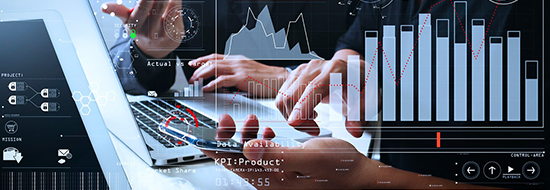Data Analytics & Business Intelligence
![]() Our Services
Our Services
Data Analytics & Business Intelligence
Overview: Data Analytics and Business Intelligence (BI) empower organizations to make informed decisions by collecting, analyzing, and interpreting vast amounts of data. These insights drive business strategies, optimize performance, and fuel growth. With the integration of AI and machine learning, businesses can uncover advanced insights, while predictive analytics and data visualization tools make complex information accessible and actionable.

Key Features
Data Collection and Integration:
- Aggregation of structured, semi-structured, and unstructured data from diverse sources (CRM systems, social media, IoT devices, etc.).
- Integration with existing data infrastructures to create a unified data ecosystem.
Advanced Data Processing:
- Use of big data technologies (e.g., Hadoop, Spark) to process and analyze massive datasets quickly and efficiently.
- Real-time data processing capabilities to monitor business activities in the moment.
Insight Generation:
- Identifying actionable insights through deep analysis of customer behavior, market trends, operational inefficiencies, and more.
- Segmentation of data to better understand specific business functions, customer demographics, or market segments.
Data-Driven Strategy Development:
- Leveraging insights to optimize business operations, improve marketing strategies, enhance product development, and make informed strategic decisions.
- Continuous monitoring of data for iterative strategy refinement.
AI and Machine Learning Integration for Advanced Insights
Overview: Artificial Intelligence (AI) and Machine Learning (ML) technologies bring unparalleled capabilities to data analytics by enabling systems to learn from data, identify patterns, and generate predictions without human intervention. Integrating AI and ML into business intelligence processes allows businesses to uncover advanced insights that evolve and improve over time.

Key Features
Predictive Modeling:
- Building predictive models to forecast customer behavior, market shifts, sales trends, and potential risks.
- Machine learning algorithms automatically adjust based on new data for continuous improvement in predictions.
Natural Language Processing (NLP):
- Employing NLP techniques to analyze text-based data from customer reviews, social media, and other unstructured content.
- Gaining insights from customer sentiment, preferences, and emerging trends.
Automated Decision-Making:
- Using AI-driven models to suggest or automate decisions based on data insights, enhancing business processes.
- Real-time decision-making based on data-driven predictions (e.g., supply chain adjustments, marketing strategies).
Anomaly Detection:
- Leveraging machine learning algorithms to automatically detect irregularities or outliers in data (e.g., fraud detection, operational errors).
- Quickly identifying issues before they impact the business.
Benefits:
- Uncover complex insights and patterns that would be challenging for humans to detect.
- Improve decision-making with predictive analytics that proactively address business needs.
- Enhance automation, reducing human error and resource expenditure.
Predictive Analytics and Data Visualization Tools
Overview: Predictive analytics involves using statistical algorithms and machine learning techniques to identify the likelihood of future outcomes based on historical data. When paired with data visualization tools, organizations can make sense of complex data and predict trends with clear, actionable insights that drive smarter decisions.

Key Features
Predictive Analytics Models:
- Development of statistical and machine learning models to forecast business outcomes such as sales performance, customer churn, inventory demand, and more.
- Regularly updated models to maintain accuracy as new data becomes available.
Data Visualization:
- Interactive dashboards and visualizations that make complex data easier to understand, with the ability to drill down for more detailed analysis.
- Visualization of key performance indicators (KPIs), trends, and forecasts to track progress against business goals.
Scenario Analysis:
- Using predictive analytics to simulate different business scenarios and assess potential risks or opportunities.
- Helping executives make better-informed decisions by seeing the impact of various strategic choices.
Real-Time Reporting:
- Creating real-time visual reports to keep decision-makers updated with the latest insights.
- Enabling teams to track performance and trends on the fly and make adjustments as needed.
Benefits:
- Anticipate future trends and optimize resource allocation.
- Easily understand and interpret data through intuitive, graphical representations.
- Improve forecasting accuracy, leading to smarter business strategies and better planning.
Conclusion:
By combining big data analytics, AI and machine learning, and predictive analytics with data visualization tools, businesses can uncover deep insights, predict future outcomes, and make data-driven decisions that lead to competitive advantages. Whether improving operational efficiency, targeting new customer segments, or driving innovation, these advanced analytics tools enable businesses to stay ahead in a data-driven world.












